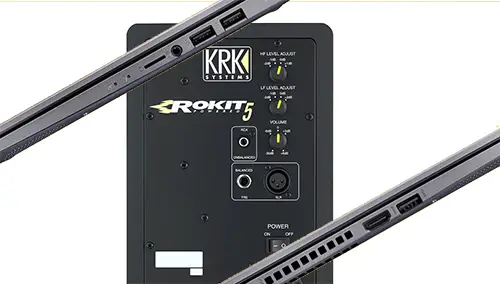Computer speakers are often a person’s first introduction to stereo sound systems. If you have a computer, the chances are that the only real audio system you have is your built-in computer speakers or external speakers connected to your computer.
Maybe you have a pair of studio monitors sitting around that you never use? Are they just collecting dust in the corner because you’re unsure if you can hook them up to your computer? Well, let’s get that answered first thing.
Can You Use Studio Monitors as Computer Speakers?
Studio Monitors can be used as computer speakers as long as you have an audio interface or the proper cables to connect the computer to the speakers. Studio monitors will typically provide a flat frequency response without enhancing the bass or treble.
Let me ask you this: Do you want high-quality sound output from your computer? If so, then connecting those studio monitor speakers will make a world of difference over those small built-in computer speakers if you’re using a laptop. Desktops usually don’t have any speakers or a pair may be built into the screen.
If you want to learn about what studio monitors are for and what they do, check out this article.
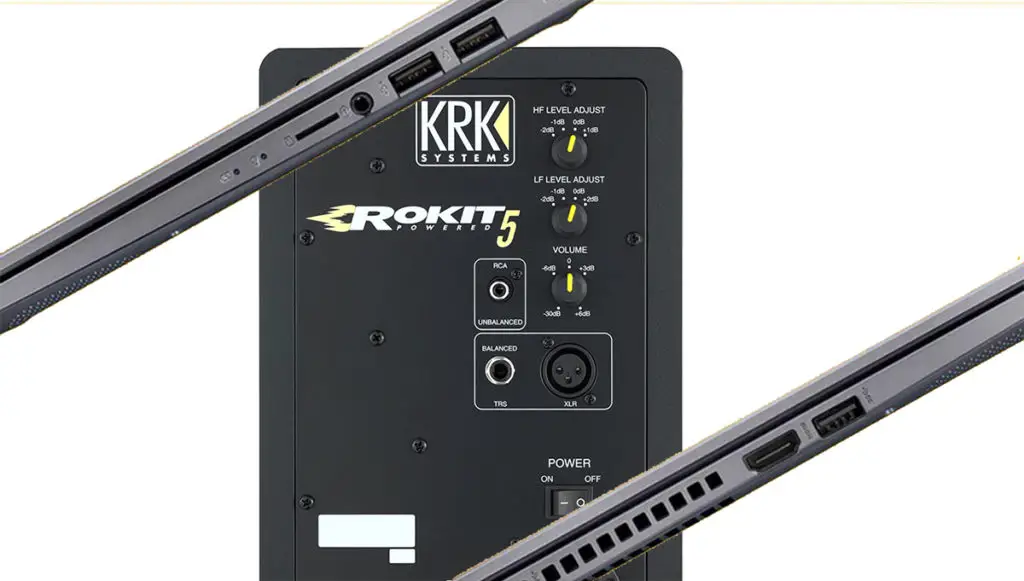
Here’s a little evidence to back up my claim. Good Quality laptop computer speakers will have a frequency response of 300 Hz – 10 kHz. To put that in perspective, entry-level studio monitors will have a frequency response of at least 50 Hz – 20 kHz.
Someone even tested the response of a MacBook Pro, which can be found on Gearspace here.
Now that you know it’s possible to connect studio monitors to a computer and that it will sound good, you’re probably wondering how to actually get them hooked up. The rest of this article will explain how to connect studio monitors to your computer, whether it be a laptop or desktop.
If you want to connect your phone or tablet to studio monitors, you can find some details in this article: Can You Use Your Phone as a Guitar Amp? Yes! Here’s How To Play Through Your Phone or Tablet
How Do I Connect Studio Monitors To My Computer?
It doesn’t matter if your computer is a PC or Mac, and it doesn’t matter if you have a set of entry-level or more professional-grade powered studio monitors. Here is what you need to know to connect studio monitors to a computer.
Studio monitors can be connected to your computer by either using an audio interface or using a cable connected to the headphone jack on the computer on one side and the monitors on the other side. An audio interface is the recommended method, as this will yield the least amount of interference from the cables.
Now let’s break that down a step further into how you do it for each method.
How To Connect Studio Monitors To An Audio Interface
If you will be using studio monitors with your computer, I recommend using an audio interface to connect the two. Studio monitors are high-quality speakers, and using an audio interface will give you the highest-quality sound. There is one situation where I recommend doing something different; read this article to learn more.
If you’re looking for a good set of studio monitors check out this article.
If you want to see what professional studios use, check out this article. I almost guarantee you don’t want to spend that kind of money.
Audio interfaces are basically external sound cards, usually connected to your computer via a USB or Thunderbolt cable. Audio interfaces receive the audio in a digital format from the computer, so no signal integrity is lost.
Audio interfaces are purpose-built to convert that digital signal into an analog signal with minimal loss to the audio quality. Technically speaking, it has a DAC (Digital-to-Analog Converter) with a high bitrate.
Audio interfaces also have balanced outputs to send the analog signal to the studio monitors. A balanced signal helps prevent noise from being introduced during the cable run.
Quick Side note: Did you know that you can use an Audio INterface without a computer? Check out this article.
Here are the steps to connect studio monitors to a computer using an audio interface:
Connect the Audio Interface to the Computer
Most Audio Interfaces connect to computers using a USB cable. The newest models will connect using USB-C connections, while previous generations may have used USB micro plugs or even firewire for Mac users.
Power the Audio Interface (if not powered over USB)
An audio interface will need to be powered to do its job. The current generation of audio interfaces can be powered over the same USB-C connection to the computer. As mentioned in the previous step, all you have to do is connect the interface to the computer.
If power over USB is not an option, you will need to plug it into an outlet on the wall. Audio interfaces will usually come with a power supply if one is required.
Connect the Studio Monitors to the Audio Interface
Audio interfaces will have balanced outputs, so you need to make sure you are using the correct cable.
Balanced cables can use a TRS (Tip, Ring, Sleeve) connector or a 3-pin XLR connector.
¼ inch TRS jack to jack cable:
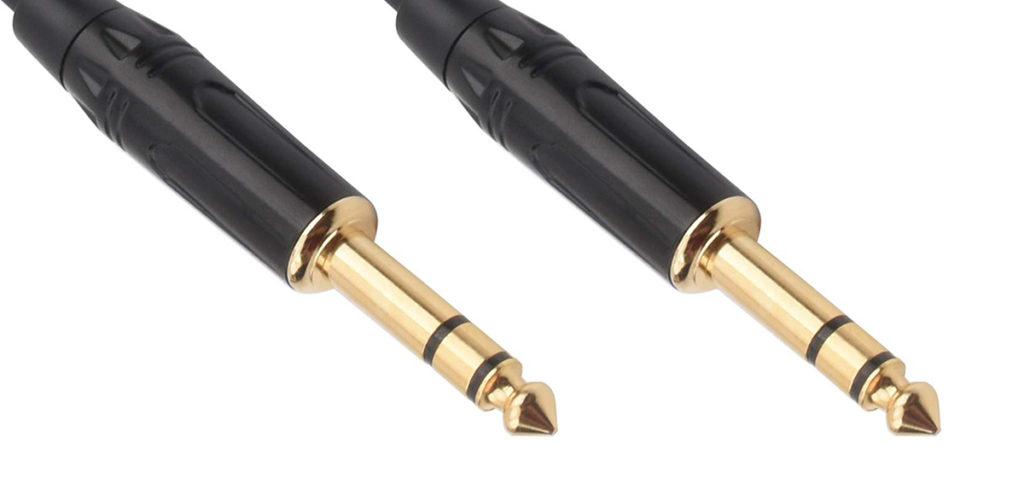
¼ inch TRS jack to 3-pin male XLR cable:

Here are links to quality balanced cables on Amazon:
¼ inch TRS jack to 3-pin male XLR cable
How To Connect Studio Monitors To A Computer Without Interface An Audio Interface?
Your desktop computer (PC or Mac), laptop, or even your phone have DACs (Digital-to-Analog Converters) built into them. DACs convert your digital audio into analog audio, which is what we hear when we plug headphones into the headphone jack.
The caveat here is that the DACs in your computer or phone are not as good as the ones found in an audio interface. Secondly, the output is not balanced, allowing noise to be introduced as the signal is sent to your speakers.
Nonetheless, here is how to connect studio monitors to a computer without an audio interface.
To connect a pair of studio monitors to your laptop or desktop PC without an audio interface, you will need a 3.5mm (1/8-inch) TRS to RCA cable or a 3.5mm TRS Male to Left and Right 1/4-inch TS.
You will have to select the correct cable based on your monitor’s input, but most studio monitors will have a 1/4″ input.
Cables are available in various lengths, but shorter is generally better. The shorter the cable, the less signal loss you will have, especially in the higher frequencies.
Here are the steps to connect studio monitors to a computer without using an audio interface:
Find the audio output on your computer
The audio output is a 3.5mm hole that you would plug your headphones into. It is usually a headphone jack but can sometimes have a TRRS jack allowing for microphone input while also allowing stereo output.
Here is an example:
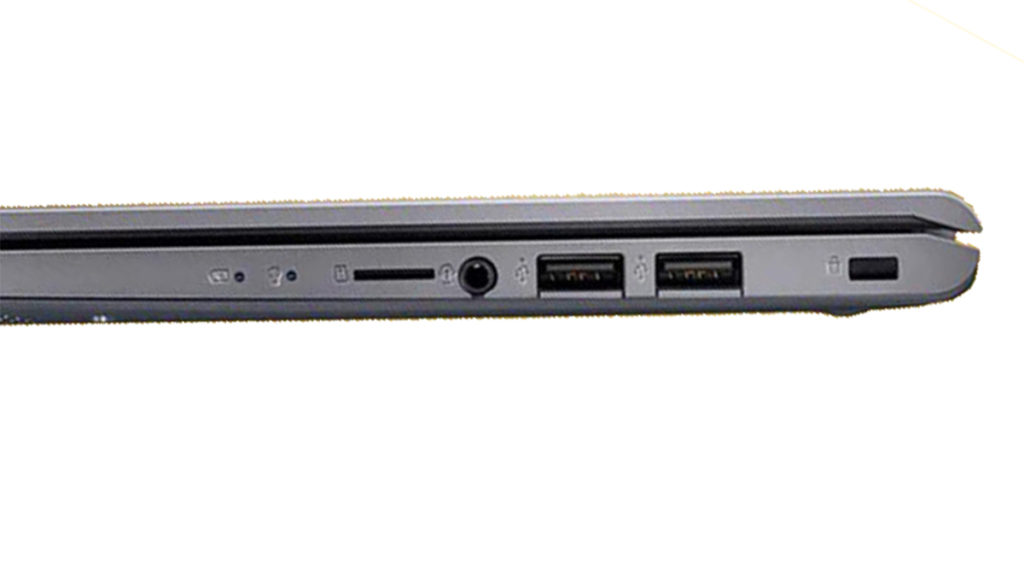
Find the correct input on your studio monitors
Studio monitors will typically have a couple of input options. The most common inputs are a balanced 1/4-inch TRS jack and a Balanced XLR jack.
Entry-level monitors commonly have unbalanced inputs, such as an RCA jack or a 3.5mm (1/8-inch) jack.
Here’s an example of the back of a KRK RP5G3 ROKIT 5 G3 studio monitor. It has all the inputs mentioned, except the 1/8-inch jack.
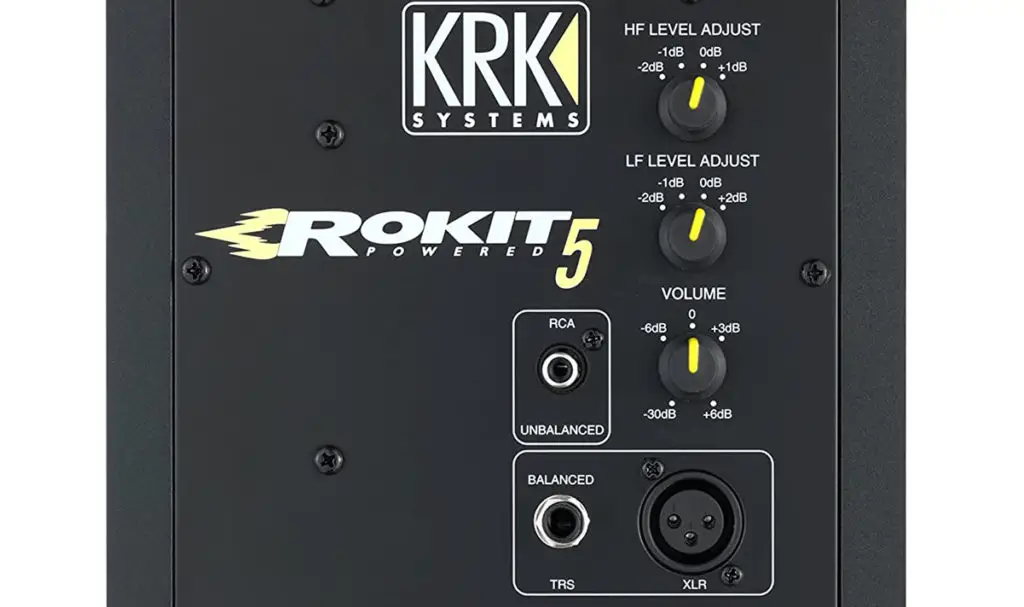
Here is a link to the KRK G4 version that replaces the G3:
Purchase the proper cable for your studio monitors
If you are plugging in straight from the computer, use the unbalanced jack if available. In the case of the KRK mentioned above, that would be the RCA jack.
The second option would be to use 1/4-inch balanced input However, you wouldn’t get the benefits of a balanced signal.
Connect the cable from the computer to the monitors
With the cable in hand, you are ready to hook up the monitors to your computer.
Your cable may have one input plug that is red or has a red ring, and the other should be white. That is to signify which one is left and which one is right, although it won’t do any harm if you get it mixed up.
Red is for the Right side, and White is for the Left side.
Here is a video covering the methods described in this article:
How To Connect Multiple Studio Monitors To An Audio Interface?
What happens if you only have one set of stereo outputs on your audio interface but more than one pair of studio monitors? Perhaps you have a couple of passive monitors and a pair of active monitors side-by-side. How do you connect it all? How do you combine and join multiple studio monitors to an audio interface?
Multiple studio monitors can be connected to an audio interface by being routed through a monitor controller. A monitor controller receives the input from the audio interface and routes it to the desired set of monitors.
Monitor controllers are often capable of a lot more than just sending one input to multiple outputs. They usually accept multiple inputs. For example, you could connect a smartphone to one of the Aux inputs and enjoy some music that way.
They’re loaded with various features, but here are two examples. The first is one with minimal features that will do just this job. Don’t get me wrong; it’s excellent at what it does. The second one is one of the most highly-rated monitor controllers and is loaded with features. I think you’ll probably notice the price difference.
Related Questions
While we’re on the topic of connecting studio monitors to your computer, I thought now would be a good time to answer this question.
If you want to know if studio monitors are good for listening to music, check out this article.
Are Studio Monitors Good For Playing Video Games?
I used a pair of bookshelf speakers connected to an A/V receiver as my PC’s audio output for a long time. The quality of the audio was excellent. However, when it comes to gaming, more than just high-quality sound is required.
For games where directional sound critically matters, it is better to use a good-quality gaming headset instead of studio monitors. Studio monitors are good for music and games where directional sound doesn’t affect play.

